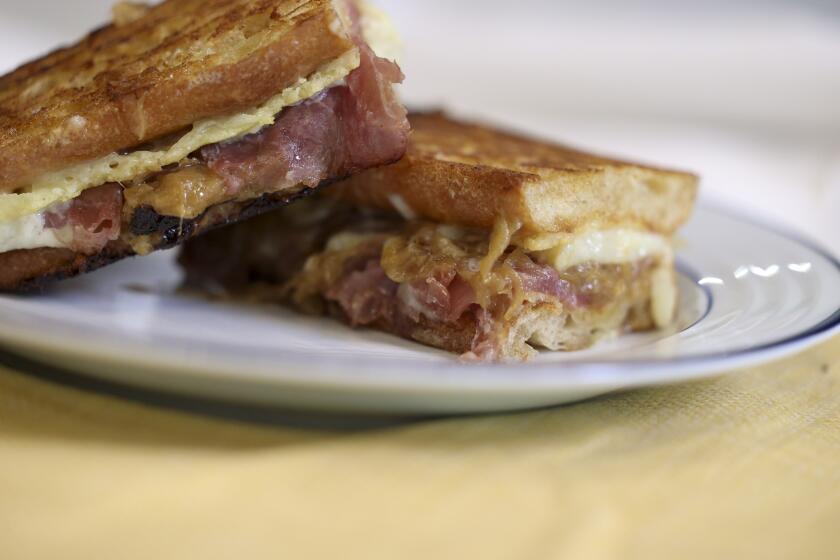Poof! You’re now a rich and silky wine
WISH your Two Buck Chuck were just a little smoother? Now, as crazy as it sounds, there’s a simple pour-spout gizmo that claims to take the edge off cheap wine -- with magnets. The gadget, available in wine shops and online for about $30, is making waves -- and raising some eyebrows -- in the wine world.
When you place the BevWizard, as inventor Patrick Farrell has named it, on the business end of a wine bottle and pour through it, the wine becomes rounder, softer and less tannic, as if by some miracle someone has taken a power sander and smoothed out the rough edges of the wine. In certain wines, the effect can be dramatic.
But while nearly everyone can detect a difference using the BevWizard, not everyone falls sway to its magic.
Sommeliers and other wine purists look upon this sort of manipulation with suspicion. But retailers think it just might get people afraid of robust tannins to be a little more adventurous when buying.
Farrell, a physician who lives in Huntington Beach, has been demonstrating the powers of his gadget at wine festivals and events such as Hospice du Rhone, in Paso Robles last month, and even Vinexpo, in Bordeaux, France, where Farrell showed a prototype last year. It was there that Robin Kelley O’Connor, president of the Society of Wine Educators, first encountered it being used on some coltish Bordeaux barrel samples.
“Farrell was using his pourer and saying, ‘Try this one, try that’ and asking us which we preferred,” recalls O’Connor, “and the wines poured through his contraption were so much smoother, and the aromas weren’t affected.”
The secret of Farrell’s device is powerful magnets that are molded into the plastic sleeve of the BevWizard. Magnets, according to Farrell, can change the molecular structure of a wine’s tannins. Tannins are compounds found in the skins and seeds of all grapes, and in oak, that turn up in red wines and some whites too (as well as black tea and coffee).
Tannins structure the wine, and their natural astringency is a very important aspect of how a wine feels in the mouth and how it finishes. Though they’re said to have no taste, tannins seem to greatly affect flavor; they can, for example, contribute a sensation of bitterness, pleasing or not, to the wine.
Most wines with a lot of tannins feel more tannic in their youth, but tend to soften with age because with time, the tannin molecules bind with each other for a softer, more burnished mouth feel. Farrell’s gizmo accelerates that process dramatically. The magnet encourages the binding process and wines taste softer.
O’Connor, a Bordeaux expert, didn’t seem altogether certain that having his experience mediated in just this way was the best thing for him. “I think it’s an interesting dilemma for everybody,” says O’Connor, “and you really have to ask yourself what do you want from the wine? Will you always be looking for those ‘reformed’ tastes and flavors?” For O’Connor, the answer was “probably not.”
“But for the casual drinker who has no choice but to drink young,” he said, “and doesn’t always know what they’re getting into when they open a bottle, this could have a lot of value.”
Soaking up information
FARRELL became interested in wine during a period of convalescence in the late ‘90s, and his interest turned into a voracious appetite for information. It led him to study for and eventually pass the test to become a Master of Wine, an English certification of expertise considered to be one of the world’s most rigorous. Passing the Master test involves blind tasting and being able to identify a wide range of wines from throughout the world.
Some members of the club where Farrell swims learned he was an expert in wine. They were involved in the use of magnets to change the polarity of salts in water lines, and thought they might have a use in the wine industry, so they approached him with a very crude prototype.
“I tried it out of politeness,” he says, “I really thought there was no way that it would actually do anything.” But he poured a Barossa Shiraz through it, and to his great surprise, it made the wine smoother. “And I tried it on a Bordeaux from the Medoc that had some harsher, greener tannins,” Farrell says, “and the sensation of those tannins was reduced.”
So he started doing research. The first magnetic device used on wine and spirits, he learned, was registered at the U.S. Patent Office in 1900, designed, according to the patent document, “to make anyone using it a powerful health-giving suggestion of electricity and magnetism.”
After that, a few magnetized pourers reached the market, but they usually attached outside of the neck, and they had a weaker charge than the one he and his partners were developing. On a hunch, he drilled a hole in his cylinder to let in more oxygen, which acted like an instant decanter. And on most wines aged in oak, it seemed to make a big difference in their taste and mouth feel.
So how much softer are the tannins of a wine that has passed through a BevWizard? It depends on the wine’s tannic structure. “The device works best on changing hard, unripe tannins,” Farrell explains. “The structure of those tannins change to be closer in structure to ripe tannins.” A wine that’s already balanced, he thinks, doesn’t need changing, and the device might actually disrupt the balance a little -- again, depending on your taste.
Farrell recently attended a wine-tasting group I belong to to demonstrate the BevWizard.
He may be a wine geek, but our group that night was pretty geeky in its own right. There was Bonnie L. Graves, a wine consultant who was a sommelier at Spago and Jean Georges in New York; Tim Smith, who used to pull corks at Rix and the Fenix; Mike Greene, general manager of Woodland Hills Wine Co.; and our host, Justin Gallen, who sells Italian and Austrian wines for an importer called Vin Divino.
When we were finished with the whites, Farrell opened a Washington Cabernet, and asked us to pour a taste. Then he pulled out his gizmo, pressed it down on the neck of the same bottle, and instructed us to pour another taste through the device into another glass.
Farrell then asked us to try them. The first glass tasted like the decent, four-square Washington State Cabernet Sauvignon it was, picked up by Farrell for about $14 on the way over. It had good blackberry fruit and tannins that were substantial, mildly astringent, slightly harsh and a bit clunky.
And the second glass? It was the same wine, with the same fruit and similar aromas. The quibbles we’d had with the tannins had vanished. The wine had grown ampler, smoother and rounder; the harshness was gone, vanished -- poof -- like it was never there. We all agreed that the BevWizard had changed the wine. But beyond this, we agreed on nothing.
A blanket effect?
SMITH noted that stripping the wine of its upper register of tannin pushed the wine’s fruit component into a newer, plumper role. Gallen noted that smoothing those tannins broadened the texture, but it also gave the impression that the wine had been muffled slightly, as if covered with a blanket.
The question ultimately became, how comfortable were we with the change?
Like Farrell, all of us in the room had tasted thousands of wines during our careers, and we had a healthy set of assumptions as to what a wine was supposed to taste like and when. A 2003 Cabernet from Washington State, a warm vintage from a warm place, was supposed to taste a little tannic; what did it mean to strip the wine of this marker, even if that marker wasn’t to everyone’s taste?
Graves was perhaps the most resistant. “I bring a sommelier’s bias to gizmos in general,” she said. But that wasn’t her only objection; she worried that it would encourage American impatience. People would turn to the BevWizard, she worried, for instant age on wines that may not be ready to drink.
“If it makes people pour wines before they’re ready, just because they can, I take pause,” Graves explained. “There’s no need to cellar your Barolo, because suddenly you have this thing that makes it soft and round and approachable.”
But Greene, a retailer, disagreed; this sort of device wasn’t going to appeal to the average Barolo drinker, who knows the pleasure of cellaring wine -- “the thrill of delay,” as Graves put it. But it would be perfect for the casual wine drinker who wasn’t crazy about tannins.
“I’ve got lots of customers who come in and ask for smooth wines, without that ‘bite’ common in California Cabernet or Petite Sirah,” he said. “A thing like this that rounds out the edges would have a loyal following.”
Greene, who, like many people in the wine industry, once worked in the music industry, made an elegant comparison. “It’s like CDs,” he said. “Compact discs are basically a ‘mid-fi’ format -- not the best fidelity for hearing music. But they got people to enjoy music again.”
Farrell, who was remarkably impassive as we hashed this out, decided then to pipe in. For whatever reason, he explained, the device was most effective on harsher, more obtrusive tannins, like those found in wines made with unripe fruit, or wines that used oak chips or staves for flavor. “This thing turns Two Buck Chuck into Six Buck Chuck,” he said. Why not Twelve Buck? “I don’t think so,” he said.
The BevWizard is available for about $30 at Gourmet Cheese & Wine in Redondo Beach, (310) 214-2122; Cooks Family Market in El Segundo, (310) 615-1990; Vendome Wine & Spirits in Toluca Lake (818) 766-9593; the Wine House in Los Angeles, (310) 479-3731; Morry’s of Naples Wine Shop in Long Beach, (562) 433-0405; Woodland Hills Wine Co. in Woodland Hills, (818) 222-1111; and online at www.bevwizard.com.
More to Read
Eat your way across L.A.
Get our weekly Tasting Notes newsletter for reviews, news and more.
You may occasionally receive promotional content from the Los Angeles Times.










